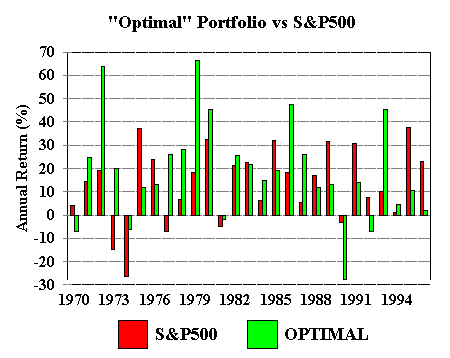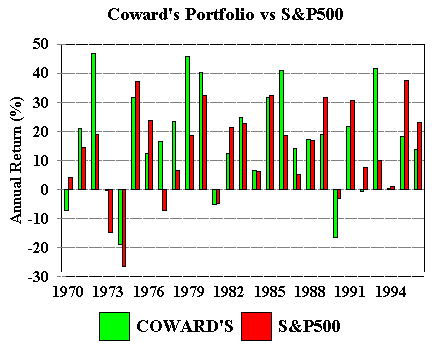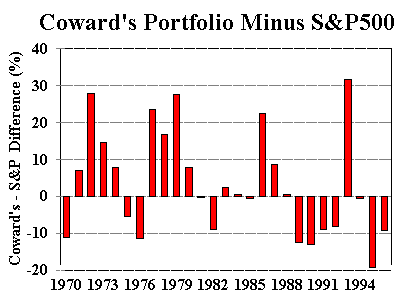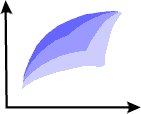![]()
The Loneliness of the Long Distance Asset Allocator
It's late in the evening. The children have gone to bed, and you are
all alone with your IRA accounts and spreadsheet, wrestling with your asset
allocation strategy. You nod off and reawake in an alternative universe.
Strange tropical plants are growing out of your keyboard, and snow wafts
down from the ceiling.
A genie appears, looking like some vague demented amalgam of Mario Vargas
Llosa and Harry Markowitz. "The spirits inform me that you are a seeker
of efficient portfolios," he intones. "Oy vey," you respond,
"Excedrin headache number 11." The genie offers a sly smile.
He tells you that in his pocket are the annual returns for for the next
27 years for the MSCI regional indexes (Europe, Japan, Pacific X Japan),
US large and small stocks, and an index of gold mutual funds.
Can you see them? Of course not. The genie will, however, tell you what
mix of these assets will produce the highest return over the next 27 years.
Still interested? You bet.
The genie suddenly disappears, and along with him the snow and tropical
plants. Rats! Just another asset allocation hallucination. But perhaps
you have learned something. Your computer contains the returns for the
past 27 years for these indexes. You quickly calculate the optimal mix
of these six assets for the 1970-96 period. It consists of just 3 of the
assets: 35% Japanese, 28% small US, and 37% gold. Very unconventional,
but it yielded 16.85% over the 27 year period, versus 12.27% for the S&P500.
(Annual rebalancing is assumed.) The annual returns for this optimal mix
and the S&P are plotted below:

What is striking is just how different the annual returns of these two
portfolios are. In order to better appreciate this, I've plotted the "tracking
error" (optimal portfolio minus S&P return) of the portfolio:
Above the line, the "optimal" portfolio's annual return was
higher, below it the S&P was better. Despite the fact that the optimal
portfolio yielded 4.58% compounded more than the S&P, it lagged it
in 12 out of 27 years, or 44% of the time. The underperformance was not
trivial either, on one occasion 27%. In other words, international diversification
is not a free lunch. You must be willing to feel like a fool for extended
periods of time in order to reap its benefits. If you're a small investor,
that is not such a high price to pay. For the professional money manager
the cost is much higher; lagging the benchmark by such margins turns you
into instant roadkill. The small investor definitely has an unfair advantage
over the professional in the asset allocation arena.
The Coward's Portfolio
The "optimal" portfolio has a most peculiar allocation. Further,
it is dubious that the same allocation will be anywhere near optimal during
the next 27 years. Financial history doesn't repeat (or even rhyme,
as Mark Twain suggested). Is it possible to predict the "optimal"
portfolio allocation for the next 5, 10, or 30 years with any accuracy?
Your chances of doing so are about the same as starting at point guard
for the Bulls next season. Can an "investment professional" using
state of the art software and a Cray 23 do any better? Hardly likely.
If you've perused these pages before, you know the answer. Pick an allocation,
almost any allocation, and stick to it. How about equal amounts of all
6 of the above assets (Europe, Japan, Pacific X Japan, US large and small
stocks, and gold equity)? The 27 year return of this "coward's strategy"
was 15.33% -- just 1.5% less than the best possible strategy. Again, even
though this strategy beat the S&P by 3% annualized, it lagged the S&P
in 13 out of 27 years -- almost half of the time. Below are the annual
returns for the equally weighted coward's portfolio and S&P, followed
by the graph of its S&P tracking error.


Which brings us to the past decade. For those of you who've been living
in a trappist monastery since 1987, the S&P 500 has been the only place
to be. For the past 10 years the S&P has returned 15.26% versus 6.59%
for the "optimal" portfolio and 10.44% for the "cowards"
(equally weighted) portfolio. For internationally diversified investors
it's been a very long decade indeed.
So which period do we rely on for guidance -- the past decade of US large
cap outperformance or the longer period of global portfolio dominance?
There is no sure answer to this dilemma. However, it is likely that longer
periods provide more reliable data. Asset return divergences generally
revert; the underperformance of foreign assets during the past decade is
probably simply "payback" for their overperformance before 1987.
If this is true then the next 10 years should again provide handsome rewards
for foreign diversification.
Hence, the loneliness of the long distance asset allocator. Holding foreign
assets during the past decade has been a lonely, frustrating experience.
Few things offend human nature more than watching helplessly as your neighbors
become effortlessly rich investing in the big blue chips. Keep the faith
-- your day will come.
![]()
![]()
copyright (c) 1997, William J. Bernstein
